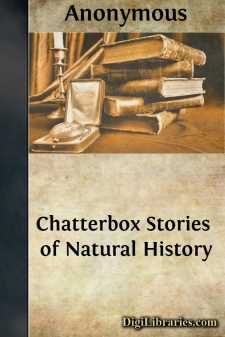Categories
- Antiques & Collectibles 13
- Architecture 36
- Art 48
- Bibles 22
- Biography & Autobiography 813
- Body, Mind & Spirit 142
- Business & Economics 28
- Children's Books 16
- Children's Fiction 13
- Computers 4
- Cooking 94
- Crafts & Hobbies 4
- Drama 346
- Education 46
- Family & Relationships 57
- Fiction 11829
- Games 19
- Gardening 17
- Health & Fitness 34
- History 1377
- House & Home 1
- Humor 147
- Juvenile Fiction 1873
- Juvenile Nonfiction 202
- Language Arts & Disciplines 88
- Law 16
- Literary Collections 686
- Literary Criticism 179
- Mathematics 13
- Medical 41
- Music 40
- Nature 179
- Non-Classifiable 1768
- Performing Arts 7
- Periodicals 1453
- Philosophy 64
- Photography 2
- Poetry 896
- Political Science 203
- Psychology 42
- Reference 154
- Religion 513
- Science 126
- Self-Help 84
- Social Science 81
- Sports & Recreation 34
- Study Aids 3
- Technology & Engineering 59
- Transportation 23
- Travel 463
- True Crime 29
Chatterbox Stories of Natural History
by: Anonymous
Description:
Excerpt
THE KING OF THE CASTLE.
A
S the lion is called the king of beasts, so the eagle is called the king of birds; but except that it is bigger, stronger, and swifter than other birds, there does not seem much reason for the name. It is a mistake to attribute noble or mean qualities to animals or birds, or to think they can do good or bad actions, when they can only do what God has created them to do, and as their instinct teaches.
The most powerful of the eagles is the Golden Eagle, so called because of the rich yellowish-brown bordering to its feathers. It makes its nest in the clefts of the rocky sides of the mountains, and seldom on a tree, unless where one has sprung up in between the clefts, and the tangled roots make a sort of platform. This the eagles cover with sticks, and here they make their house, living in it always, and not only when they lay eggs or have young ones.
If there are eaglets in the nest, the food is at once carried home to them, and the skinning and eating done at home. Eagles are very attentive to their young, and feed them with great care until they are able to take care of themselves.
M
RS. ZEBRA, standing with her baby by her side, asks proudly of the lookers-on, “Did you ever see such a likeness?” and certainly mother and child are very much alike, striped all over their bodies, from head to foot, and from nose to tail, with the same regular marks of black. Strong and wild by nature, the zebra family are left very much to themselves, which is a source of great happiness to the mother and child in the picture before us. “No! no! my baby is not going to become as tame as the donkey, or to draw carts and carriages like the horse; it is to have its freedom, and go just where it likes all over these large plains;”—so says Mrs. Zebra, and she means it too, for if anybody took the trouble to go all the way to the hot country of Africa, where Mrs. Zebra is at home, and tried to carry off her baby, they would find their journey a vain one, and that she would kick severely, and perhaps break the legs of the person bold enough to take away her darling.
MRS. BRUIN AND FAMILY.
H
IS is the American black bear, who is looking so lively and seemingly inviting the young folks to have a romp, which they will be only too willing to join in. The black bear is of a timid disposition, and seldom attacks man except in self-defense. The female bear is a most affectionate mother, and many stories are related showing her care and love for her young, and her sorrow and mournful cries when any evil befalls them. On one occasion a black bear with her two cubs was pursued across the ice by some armed sailors. At first she urged her cubs to increased speed, but finding her pursuers gaining upon them, she carried, pushed, and pitched them, alternately, forward, until she effected their escape from her pursuers.
W
HO has not at one time or other of his life read fairy tales and sympathized with stories of enchanted princes and princesses? I once thought of this when a country boy offered me a nest with four of the young of the Little Owl. I put them into a large cage, where they could stare at each other and at my pigeons to their hearts' content.
Let me say that this little owl is a very useful bird, for it keeps mice, bats, beetles, and other creatures in check, which might otherwise multiply too fast. On a spring or summer evening you may hear its plaintive hoot among the apple-blossoms of an orchard, or the sheaves of a cornfield. Curiously enough, this simple sound earned the little bird the name of being the harbinger of death, and peasants believed that whenever its cry was heard where sickness was in the family, the patient was sure to die.
AUROCHS.
A
N Aurochs in blind rage, charging through thick and thin, has had a fascination for me as long as I can remember. The true aurochs and this, the European Bison, ceased to exist in the British Isles, except in the Zoological Gardens; but the latter is still found wild in Lithuania, and is also carefully preserved in other parts of Russia, of which the Emperor has a herd....












